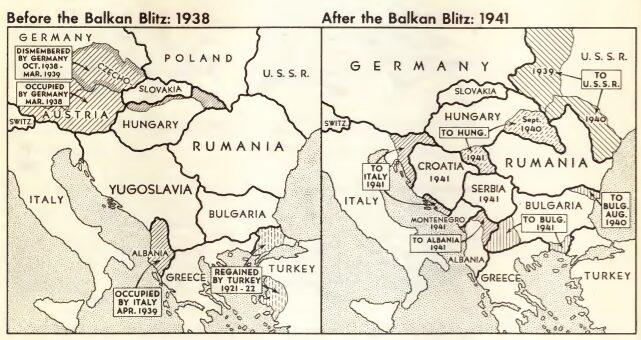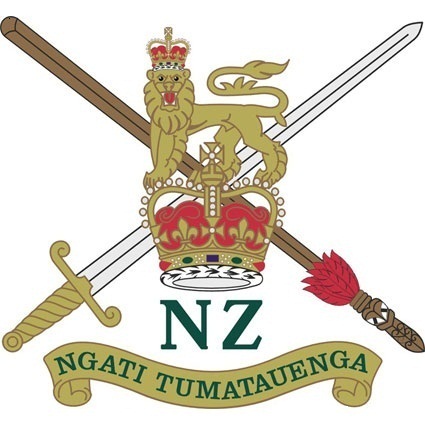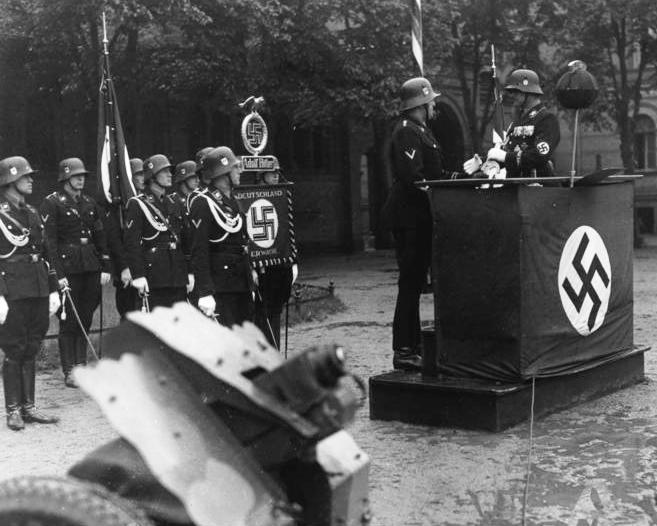|
Battle Of Tempe Gorge
The Battle of Tempe Gorge, also known as the Battle of Pinios Gorge, was a rearguard action fought by Australian and New Zealand troops during the German invasion of Greece on 18 April 1941. The battle was fought amidst the advance of German forces through central Greece, and saw a brigade-sized element dubbed "Anzac Force" fight a delaying action against elements of two German divisions, supported by armoured forces. During a day of hard fighting, the defending Anzacs suffered heavy casualties and were forced back from the gorge, but their stand allowed other Allied forces to withdraw through Larissa, and afterwards a new defensive position was established around Thermopylae. Background As the main Allied contingent retreated from German forces towards the south of Greece, a holding action was determined to be needed to delay the pursuing Germans at Tempe Gorge, a site deemed suitable for the defence. The force allocated for this action was dubbed "Anzac Force". It was relati ... [...More Info...] [...Related Items...] OR: [Wikipedia] [Google] [Baidu] |
Balkans Campaign (World War II)
The Balkans campaign of World War II began with the Italian invasion of Greece on 28 October 1940. In the early months of 1941, Italy's offensive had stalled and a Greek counter-offensive pushed into Albania. Germany sought to aid Italy by deploying troops to Romania and Bulgaria and attacking Greece from the east. Meanwhile, the British landed troops and aircraft to shore up Greek defences. A ''coup d'état'' in Yugoslavia on 27 March caused Adolf Hitler to order the conquest of that country. The invasion of Yugoslavia by Germany and Italy began on 6 April 1941, simultaneously with the new Battle of Greece; on 11 April, Hungary joined the invasion. By 17 April the Yugoslavs had signed an armistice, and by 30 April all of mainland Greece was under German or Italian control. On 20 May Germany invaded Crete by air, and by 1 June all remaining Greek and British forces on the island had surrendered. Although it had not participated in the attacks in April, Bulgaria occupied p ... [...More Info...] [...Related Items...] OR: [Wikipedia] [Google] [Baidu] |
7th Anti-Tank Regiment (New Zealand)
The 7th Anti-Tank Regiment was an anti-tank artillery regiment of the New Zealand Military Forces raised during the Second World War. It saw service as part of the 2nd New Zealand Division during the Greek, North African, Tunisian and Italian campaigns, before being disbanded in December 1945. Formation At the beginning of the Second World War, New Zealand intended to raise an anti-tank regiment, but did not possess any anti-tank guns with which to properly train the gunners. It was therefore decided in late 1939 to initially form and train an anti-tank battery in the United Kingdom from New Zealanders already present there. 34 Battery was formed at Aldershot and later joined the First Echelon, 2NZEF, in Egypt in April 1940. Meanwhile, a further three batteries were formed in New Zealand. 33 battery travelled with the Third Echelon, 2NZEF, and joined 34 Battery in September for further training in Egypt. 31 and 32 batteries were sent to the UK for training and only joined the r ... [...More Info...] [...Related Items...] OR: [Wikipedia] [Google] [Baidu] |
Platamon
Platamon, or Platamonas (, ''Platamónas''), is a town and sea-side resort in south Pieria, Central Macedonia, Greece. Platamon has a population of about 2,000 permanent inhabitants. It is part of the Municipal unit of East Olympos of the Dio-Olympos municipality. History The ancient settlement Herakleion was situated near the present town Platamon. In 169 BC. the Romans took their military camp on the plain between Herakleion and ancient Leivithra to start their campaign against Macedonia. Its most famous landmark is the 13th century Byzantine Castle of Platamon, built strategically along the main road from Thessaly to Macedonia through the Vale of Tempe. Geography Platamon is situated on the Aegean Sea coast, 25 km southeast of Mount Olympus. Adjacent beach towns are Neoi Poroi to the southeast and Neos Panteleimonas to the northwest. It is 33 km south of Katerini and 43 km northeast of Larissa. The town is well known for its vast natural springs ... [...More Info...] [...Related Items...] OR: [Wikipedia] [Google] [Baidu] |
Gonnoi
Gonnoi ( el, Γόννοι, before 1927: Δερελί - ''Dereli'') is a former municipality in the Larissa regional unit, Thessaly, Greece. Since the 2011 local government reform it is part of the municipality Tempi, of which it is a municipal unit. Population 2,462 (2011). The municipal unit has an area of 113.333 km2. The municipality was created under the Kapodistrias Law in 1997 out of the former communes of Gonnoi, Kallipefki, Itea and Elaia. About southeast of the town lies the site of the ancient city of Gonnus, after which the present town is named. Subdivisions The municipal unit Gonnoi is subdivided into the following communities (constituent villages in brackets): *Gonnoi (Gonnoi, Elaia) * Itea * Kallipefki Population History The ancient city of Gonnoi was situated in a hillside near the contemporary Gonnoi, now called "Kastri" (i.e. castle). The area was consecutively ruled by the Kingdom of Macedonia, the Roman, the Byzantine and the Ottoman Empires. With ... [...More Info...] [...Related Items...] OR: [Wikipedia] [Google] [Baidu] |
Larissa
Larissa (; el, Λάρισα, , ) is the capital and largest city of the Thessaly region in Greece. It is the fifth-most populous city in Greece with a population of 144,651 according to the 2011 census. It is also capital of the Larissa regional unit. It is a principal agricultural centre and a national transport hub, linked by road and rail with the port of Volos, the cities of Thessaloniki and Athens. The municipality of Larissa has 162,591 inhabitants, while the regional unit of Larissa reached a population of 284,325 (). Legend has it that Achilles was born here. Hippocrates, the "Father of Medicine", died here. Today, Larissa is an important commercial, transportation, educational, agricultural and industrial centre of Greece. Geography There are a number of highways including E75 and the main railway from Athens to Thessaloniki (Salonika) crossing through Thessaly. The region is directly linked to the rest of Europe through the International Airport of Central Greec ... [...More Info...] [...Related Items...] OR: [Wikipedia] [Google] [Baidu] |
Pineios (Thessaly)
The Pineios ( el, Πηνειός, Pineiós, , , referred to in Latin sources as Peneus) is a river in Thessaly, Greece. The river is named after the god Peneus. During the later Middle Ages, it was also known as the Salamvrias or Salavrias (Σαλα ��ριάς). It flows from the Pindus mountains through the Thessalian plain and empties into the Aegean Sea, northeast of the Vale of Tempe, near Stomio. It creates a large delta, well known for its beauty and for many animal species, protected by international environmental treaties. Its total length is 205 km. Its drainage basin is . Its source is near the village Malakasi, on the eastern slope of the Pindus main range, east of Metsovo. The Meteora region and the city of Larissa lie along the Pineios. Trikala lies on its tributary, the Lithaios. In the 1960s, a freeway connecting Athens and Thessaloniki was constructed in much of the Vale of Tempe. Three ships of the Hellenic Navy have been named after the river. ... [...More Info...] [...Related Items...] OR: [Wikipedia] [Google] [Baidu] |
Battle Of Vevi (1941)
The Battle of Vevi (or Veve, el, Μάχη της Bεύης), in Greece, also known as the Battle of the Klidi Pass, was part of the Greek campaign of World War II. It took place on 11–12 April 1941, north of the town of Amyntaion, close to the northwestern Greek border. Allied troops fought forces from Nazi Germany. Background German forces invaded Greece and southern Yugoslavia from Bulgaria in the first week of April 1941. Following the collapse of resistance in Yugoslavia, the left flank of the Vermion line held by Greek and British Empire forces became exposed. A new plan intended that Imperial British forces would hold off Germans forces in western Macedonia, until non-motorised Greek infantry units had withdrawn on foot from Mount Vermion to Mount Siniatsiko, and a new defensive line had been formed between Mount Olympus and the Aliakmon River. [...More Info...] [...Related Items...] OR: [Wikipedia] [Google] [Baidu] |
Waffen SS
The (, "Armed SS") was the combat branch of the Nazi Party's '' Schutzstaffel'' (SS) organisation. Its formations included men from Nazi Germany, along with volunteers and conscripts from both occupied and unoccupied lands. The grew from three regiments to over 38 divisions during World War II, and served alongside the German Army (''Heer''), ''Ordnungspolizei'' (uniformed police) and other security units. Originally, it was under the control of the (SS operational command office) beneath Heinrich Himmler, the head of the SS. With the start of World War II, tactical control was exercised by the (OKW, "High Command of the Armed Forces"), with some units being subordinated to (Command Staff Reichsführer-SS) directly under Himmler's control. Initially, in keeping with the racial policy of Nazi Germany, membership was open only to people of Germanic origin (so-called " Aryan ancestry"). The rules were partially relaxed in 1940, and after the Operation Barbarossa invasi ... [...More Info...] [...Related Items...] OR: [Wikipedia] [Google] [Baidu] |
Universal Carrier
The Universal Carrier, also known as the Bren Gun Carrier and sometimes simply the Bren Carrier from the light machine gun armament, is a common name describing a family of light armoured tracked vehicles built by Vickers-Armstrongs and other companies. The first carriers – the Bren Carrier and the Scout Carrier with specific roles – entered service before the war, but a single improved design that could replace these, the Universal, was introduced in 1940. The vehicle was used widely by British Commonwealth forces during the Second World War. Universal Carriers were usually used for transporting personnel and equipment, mostly support weapons, or as machine gun platforms. Design and development The origins of the Universal Carrier family can be traced back generally to the Carden Loyd tankettes family, which was developed in the 1920s, and specifically the Mk VI tankette. In 1934, Vickers-Armstrongs produced, as a commercial venture, a light tracked vehicle that could ... [...More Info...] [...Related Items...] OR: [Wikipedia] [Google] [Baidu] |
Boys Anti-tank Rifle
The Boys anti-tank rifle (officially Rifle, Anti-Tank, .55in, Boys, and sometimes incorrectly spelled "Boyes"), is a British anti-tank rifle used during the Second World War. It was often nicknamed the " elephant gun" by its users due to its size and large bore. There were three main versions of the Boys: an early model (Mark I) which had a circular muzzle brake and T-shaped monopod, built primarily at BSA in England; a later model (Mk I*) built primarily at the John Inglis and Company in Toronto, Canada, that had a rectangular muzzle brake and a V shaped bipod; and a third model made for airborne forces with a 30-inch (762 mm) barrel and no muzzle brake. There were also different cartridges, with a later version offering better penetration. Although adequate against light tanks and tankettes in the early part of the war, the Boys was ineffective against heavier armour and was phased out in favour of the PIAT hollow charge weapon mid-war. Design and development T ... [...More Info...] [...Related Items...] OR: [Wikipedia] [Google] [Baidu] |
Ordnance QF 25 Pounder
The Ordnance QF 25-pounder, or more simply 25-pounder or 25-pdr, was the major British field gun and howitzer during the Second World War. Its calibre is 3.45-inch (87.6 mm). It was introduced into service just before the war started, combining both high-angle and direct-fire abilities, a relatively high rate of fire, and a reasonably lethal shell in a highly mobile piece. It remained the British Army's primary artillery field piece well into the 1960s, with smaller numbers serving in training units until the 1980s. Many Commonwealth of Nations countries used theirs in active or reserve service until about the 1970s and ammunition for the weapon is currently being produced by Pakistan Ordnance Factories. Initial production was slow, but by 1945, over 12,000 had been manufactured. The 25-pounder was probably the most outstanding field artillery piece used by British and Commonwealth forces in the Second World War, being durable, easy to operate and versatile. Design The design ... [...More Info...] [...Related Items...] OR: [Wikipedia] [Google] [Baidu] |
Artillery
Artillery is a class of heavy military ranged weapons that launch munitions far beyond the range and power of infantry firearms. Early artillery development focused on the ability to breach defensive walls and fortifications during sieges, and led to heavy, fairly immobile siege engines. As technology improved, lighter, more mobile field artillery cannons developed for battlefield use. This development continues today; modern self-propelled artillery vehicles are highly mobile weapons of great versatility generally providing the largest share of an army's total firepower. Originally, the word "artillery" referred to any group of soldiers primarily armed with some form of manufactured weapon or armor. Since the introduction of gunpowder and cannon, "artillery" has largely meant cannons, and in contemporary usage, usually refers to shell-firing guns, howitzers, and mortars (collectively called ''barrel artillery'', ''cannon artillery'', ''gun artillery'', or - a lay ... [...More Info...] [...Related Items...] OR: [Wikipedia] [Google] [Baidu] |




_map.jpg)




